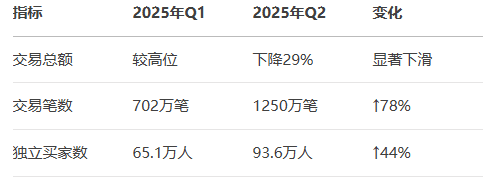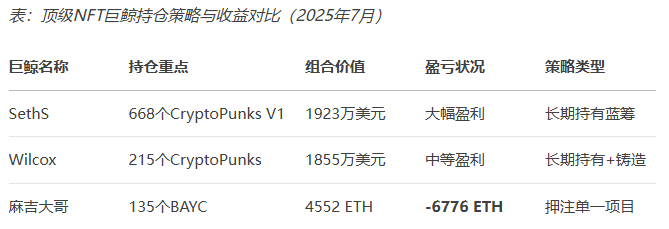The return of a star is not a scythe, but the accelerator of the market shifting gears - with this step, NFT drives from the casino to the highway.
I'm Sensing, and after six years in the industry, I've witnessed countless bubbles and illusions created by the "celebrity effect." But the 2025 wave of Maji's shift to Meme Coin and Yi Nengjing's low-key return signal something completely different: the NFT market is undergoing a "de-celebrity" value reconstruction, with the true power of crypto-native technology taking over.

1. Behind the conflicting data: retail investors enter the market, blue chips stabilize, and the speculative "heat" is cooling down
You can understand this by looking at two sets of contradictory data:
- Declining transaction volume: In Q2 2025, the total NFT transaction volume fell by 29% month-on-month, and high-priced collections (especially star projects) were not popular;
- Transaction volume surged: The number of transactions soared 78% to 12.5 million during the same period, and the number of unique buyers increased 44% to 936,000.
My interpretation: This isn't a market downturn, but rather a collapse of the "pass the parcel" hype model, with newbies rushing in. For example, Yi Nengjing's 2022 project, Theirverse, saw its value plummet from 0.219 ETH to 0.02 ETH (a 96% drop). But now that she's returned, the community has reacted with remarkable calm, with more people asking, "What can this NFT do?" rather than blindly rushing to the floor price.

2. Is the celebrity image collapsing? No, it’s just that the rules of the game have changed.
The transformation of Big Brother Maji (Huang Licheng) is the most representative:
- 2021: Spending 425 ETH on Cyborg Bored Ape, becoming a popular "Stand-Up Boss" character;
- 2025: The only losing player on the whale list (with a floating loss of 6776 ETH), mainly because of a heavy investment in BAYC and missing out on the CryptoPunks blue-chip wave.
On the other hand, true winners like whale SethS topped the list by holding 668 CryptoPunks V1s (currently worth $19.23 million). My take: Celebrity traffic can't save NFTs from falling value. NFT pricing power is shifting from celebrities to community consensus—just like Pudgy Penguins' comeback with physical toys and IP, maintaining a floor price of 16.6 ETH, which had nothing to do with celebrities.

3. The next wave: NFT is becoming “useful”, not just “expensive”
Stop focusing on JPEG price speculation! The breakthrough point for NFT in 2025 lies in "toolization":
- Fragmented NFT: Coinbase executive Jesse Pollak will fragment tweet NFTs, allowing small purchases (such as 0.001 copies), so that retail investors can also speculate on "celebrity assets";
- Penetrating real assets: Qian Fenglei invested 100 million US dollars to create the "Taohuayuan NFT", anchoring the income rights of cultural tourism real estate;
- Play and earn real utility: blockchain games use NFTs as character equipment, and players can trade across platforms (such as the upgraded version of (Axie) mode).
These innovations are transforming NFTs from collectibles in display cases into Swiss Army knives in your pocket—capable of dividends, lending, and social interaction. For example, DeFi protocols support staking BAYC to borrow USDC, offering an annualized return of 5%. This is the true realization of "utility."
Chain reaction to the crypto market: ETH is enjoying dividends, but don’t ignore the “siphon effect”
The most direct benefit of NFT's recovery is the Ethereum ecosystem:
- Of the 41% increase in NFT sales in July, Ethereum accounted for 339% of the increase ($3.2 billion/24 hours);
- But the hidden danger is that funds may flow from altcoins to NFT blue chips, especially after fragmentation lowers the threshold for participation.
When gifts flew all over Yi Nengjing's livestream, did the NFT in her hand quietly transform from a "leek sickle" into a traffic converter? Follow me and I'll break down how celebrities use NFTs to whitewash their image.